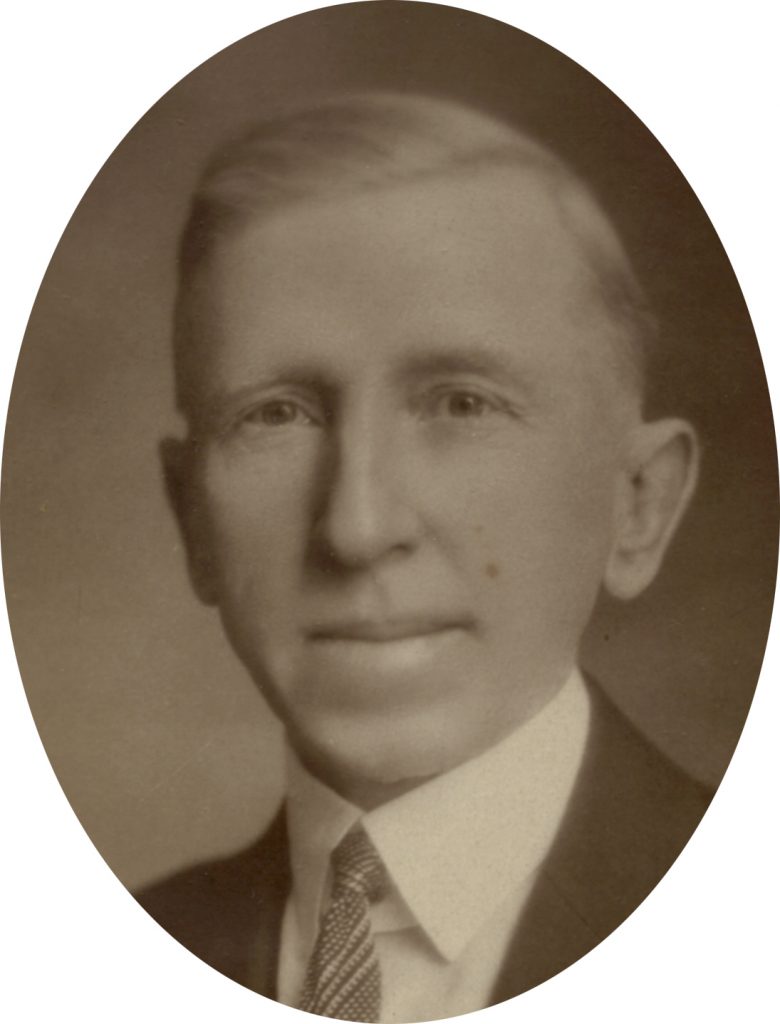
The Cook family provides me with an unending supply of stories to tell. In 2015, I wrote a post about the Cook family and the members who had served as a Wisconsin Postmaster. It still amazes me that my great-grandfather, Lewis, his father, Alfred, and his uncles, Jacob and Samuel, all served as postmasters in Marathon County, Wisconsin.
Lewis was 46 years old when President Calvin Coolidge appointed him postmaster for the city of Wausau on 30 June 1923. He served the city until his death on 4 September 1934, at the age of 57.
We have a family flag, which according to my father, measures 5’ x 9’6.” On 11 Nov 2001, my mother wrote a note sharing my father’s memory of how the flag came to be in the family. “As Bob (Robert D. Sternitzky) remembers his mother telling him: The flag was flying at the Wausau Post Office the day he (Lewis) died. (They might have run up a new one, then took it down). It (the flag) was given to his wife Effie at a service — funeral, memorial service; Bob isn’t sure.”
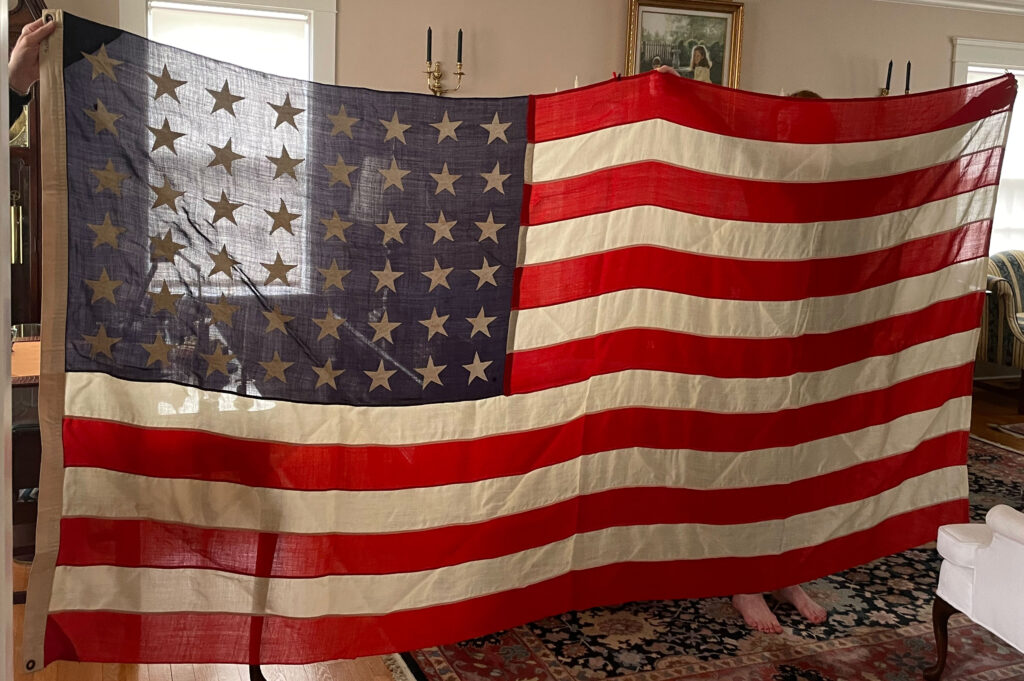
Years ago, I scrolled microfilm at the Wisconsin Historical Society library and found no reference to the flag, but now I can sit at home and search online as the paper has been made part of an online newspaper collection. While I have not found any reference to the presentation of a flag, I have amassed a lot of information about Lewis and his career as a Postmaster.
In 1929, the Wausau Daily Record-Herald reported, “a job that carries with a heavy responsibility and a great deal of work, is that of Lewis H. Cook postmaster of Wausau.” “Wausau’s postmaster must have tireless energy, patience and executive ability and Mr. Cook is well-suited to the position.”1
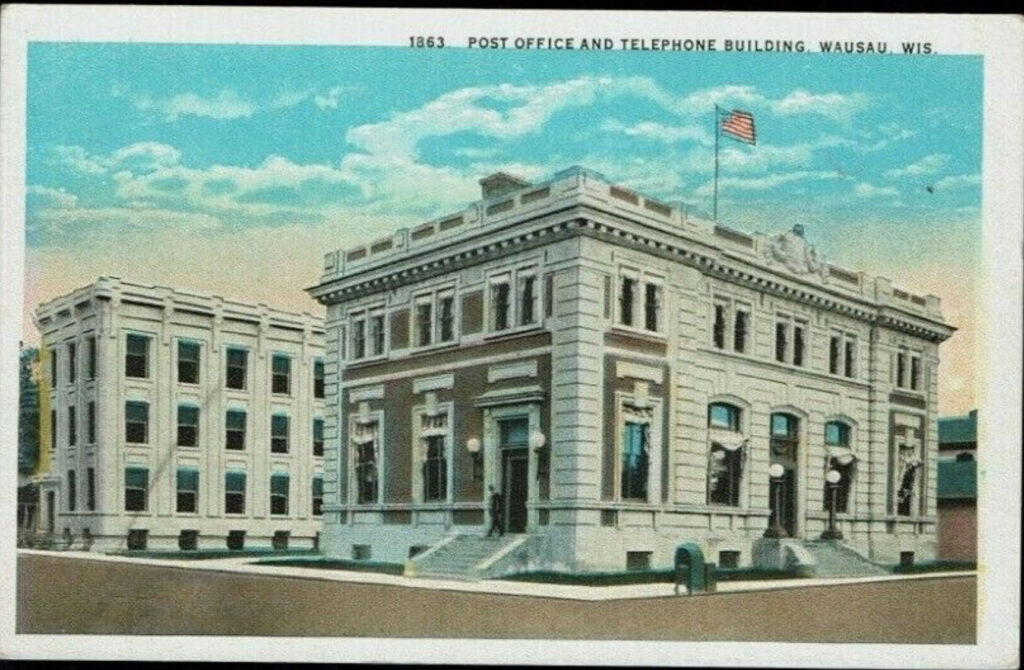
The post office had a twelve percent increase in the sale of postage, money orders, and parcel post over 1927. The post office employed 45 people, which included 14 mail carriers in the city and seven rural carriers, distributing 400 sacks of outgoing mail and the same number of sacks of incoming mail. What surprised me the most was what people sent through the mail at that time. “The wholesale grocers and farmers send much of their food parcel post as it gets to its destination more quickly than when it is sent by express. Mr. Cook said that often there are as many as half a dozen roasted chickens in the postoffice, which are to be sent to friends and relatives in other parts of the state.” Live baby chicks were also sent through the mail, and Lewis told the newspaper that “the recipients are notified at once of their arrival, and if they are unable to call for the chicks, the postoffice makes every effort to deliver them.” 2Roasted chickens and live baby chicks!
Also, in 1929, Lewis strongly encouraged the use of a “return card” on each piece of first-class mail. Up to this point, a return address was not standard, and if the letters and packages were undeliverable, they went to the dead letter office. During the 1929 Christmas season, the amount of mail that did not reach its destination due to the removal of an address or the use of an improper address was “enormous.” “Assistant Postmaster Becker believes that a million dollars in postage could have been saved patrons throughout the United States for the holiday season alone if more care had been used in addressing this mail or if a return card had been used.”3
I imagine Lewis felt that dealing with roasted chickens, live baby chicks, and the dead letter office was just part of the day-to-day job. I can also imagine the excitement in 1927 when the post office was placed “on the federal building program.” Then, frustration as the project experienced “postponements, rejection, revisions of plans and a host of other obstacles.”4 It wasn’t until March 1931 that he was given the go-ahead to procure the property needed to construct the new building. The land was secured, and the buildings were demolished, yet delays continued. In June 1934, he recommended the property be “turned over to the Chamber of Commerce to be fitted up as a parking place” to ease traffic on the main streets during shopping hours.5 The new post office would not be constructed until 1937.

On July 16, 1931, Lewis was interviewed by the Wausau Daily Record-Herald, explaining a new program he was putting into place, where “Veteran’s Caskets To Be Draped With Government Flags.6 The seventy-first congress had passed an act that stated: “Where a veteran of any war, including those women who served as army nurses under the contracts between April 21, 1898, and February 2, 1901, who was not dishonorably discharged, dies after discharge or resignation from the service, the director shall furnish a flag to drape the casket of such veteran and afterwards to be given to his next of kin, regardless of the cause of the death of such veteran.” “Regulation burial flags, size 5 feet by 9 feet 6 inches, may be secured upon application at any county seat postoffice, or at the nearest U. S. Veterans’ hospital, regional office, national home or other field station of the veterans’ administration. For use in Wausau and vicinity flags may be procured from Postmaster Cook.” The article goes on to state: “The term ‘veteran of any war’ shall mean any person, who is not dishonorably discharged and who served ‘in the military or naval forces of the United States during any period of the Mexican war, Civil war, Spanish-American wark, the World war, those women who served as army nurses during the Spanish-American war, the World war, and also those women citizens of the United States who were taken from the United States by the United States government and who served in base hospitals overseas’ and also all other wars, disturbances, insurrections, battles, expeditions, etc., in which the United States forces were called into duty.”
Finding this article has me asking this question: Is the flag we have in our family one of these flags? The size is correct. Lewis did serve in World War I, albeit on the home front, as part of Company C, 10th Infantry, Wisconsin State Guard (see the blog post: Company C, 10th Infantry, Wisconsin State Guard). If I were to guess, I would say yes, this is a government flag and not one that flew over the post office at the time of his death.
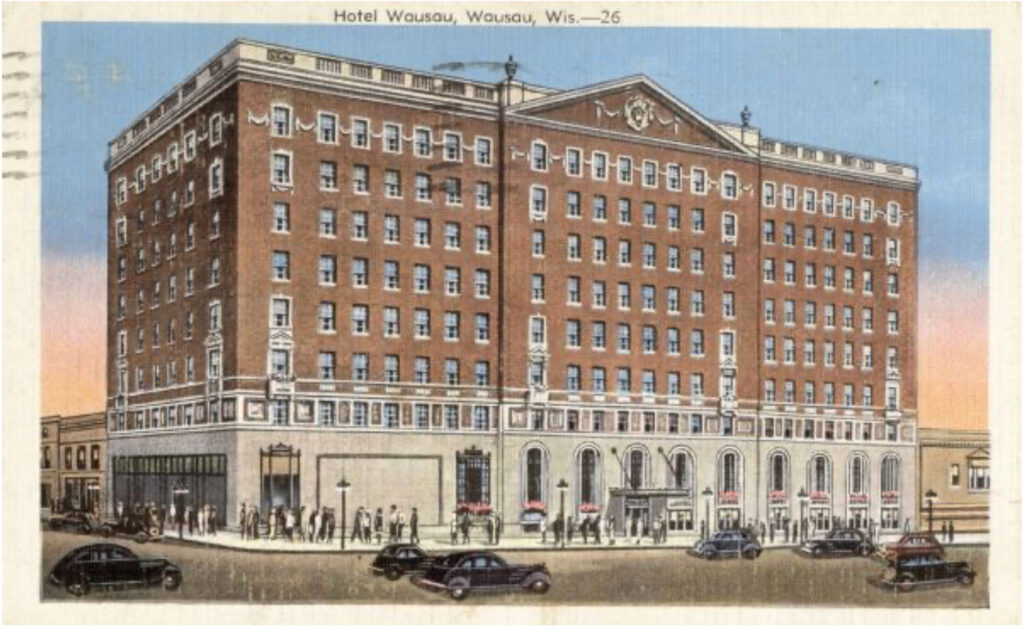
The 32nd annual convention of the Wisconsin Association of Postmasters was held in Wausau on June 19, 20, and 21, 1934. Postmaster Lewis H. Cook served as the convention planner and host. “…the local committee has made arrangements for one of the greatest conventions the men in charge of Wisconsin’s mail have ever had. The city streets are decorated with American flags and welcome signs,” and the Hotel Wausau was ready to welcome the “Postmasters of Wisconsin’s cities, villages, towns and hamlets” who “were converging on Wausau.”7
Activities for the convention included “a tour of inspection of Rib Mountain. A dance at Rothschild park,8 and an “added attraction will be the presentation of moving pictures showing the Fromm Brothers fur ranch in the town of Hamburg. A trip to the ranch is slated for Thursday afternoon.”9

The convention was a huge success, but the planning and hosting of the event had taken its toll on Lewis’ fragile health. He had been suffering from diabetes for the past ten years, and the disease had slowly taken away his eyesight. So much so that he relied heavily on Effie to be his eyes, and his daughter, Anola, had left high school without graduating so that she could assist him at the post office. Family lore states: “His vision was severely impaired by the diabetes, to the point that he needed his daughter, Anola, to drive, and work as his personal secretary during his later years as Post Master. His wife Effie, would let him know who was approaching them during a social situation so that he could greet them by name.”
Lewis passed away at his home at 125 Sturgeon Eddy Road, on September 4th at 8:15 p.m.
His obituary includes this biography of his public life: “Mr. Cook, a leading Republican for about thirty-five years was a former Marathon county clerk, state assemblyman and member of the county board of supervisors from Unity…Mr. Cook entered politics when twenty-one years of age, his first office being that of justice of the peace at Unity. Later he served in various official capacities in that village and in 1903, to promote the interests of the Republican party and agriculture, established the Marathon County Register, a weekly newspaper of which he was the owner and editor until 1910 when he came to Wausau after disposing of the weekly. He was a member of the county board of supervisors during the time he published his weekly at Unity. In 1912 he was elected Marathon county clerk, a position he held for three terms, serving until the end of 1918. In 1920 he was elected on the Republican ticket to the state assembly from the second county district. While at Madison he served on the legislature’s finance committee.” He also served as president of the Marathon County Agricultural society, and was a director of the society for 25 years. During World War I he was secretary of the local exemption board, served on the local school board.”
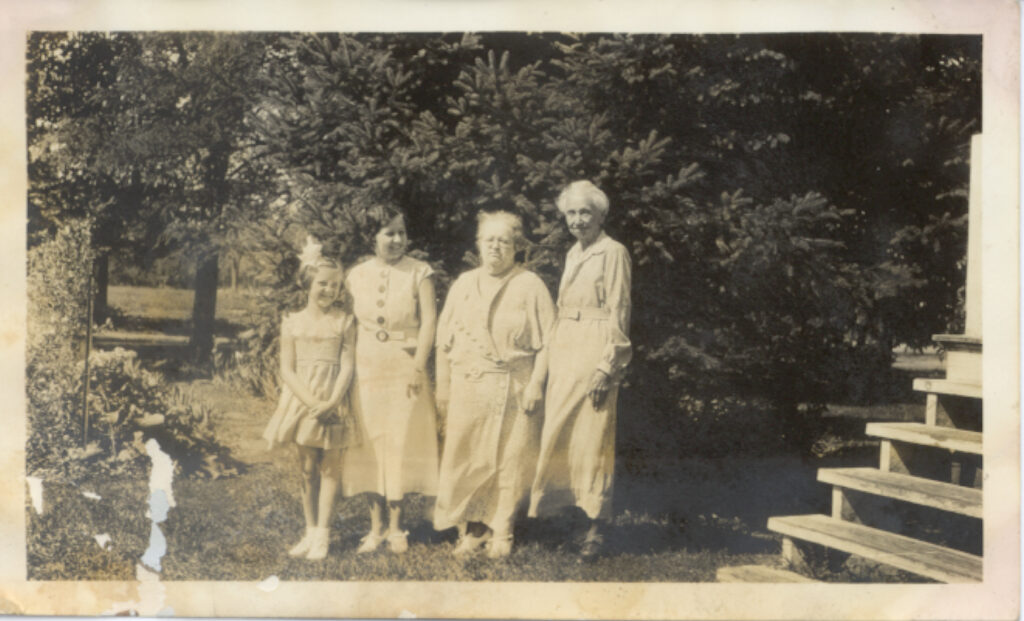
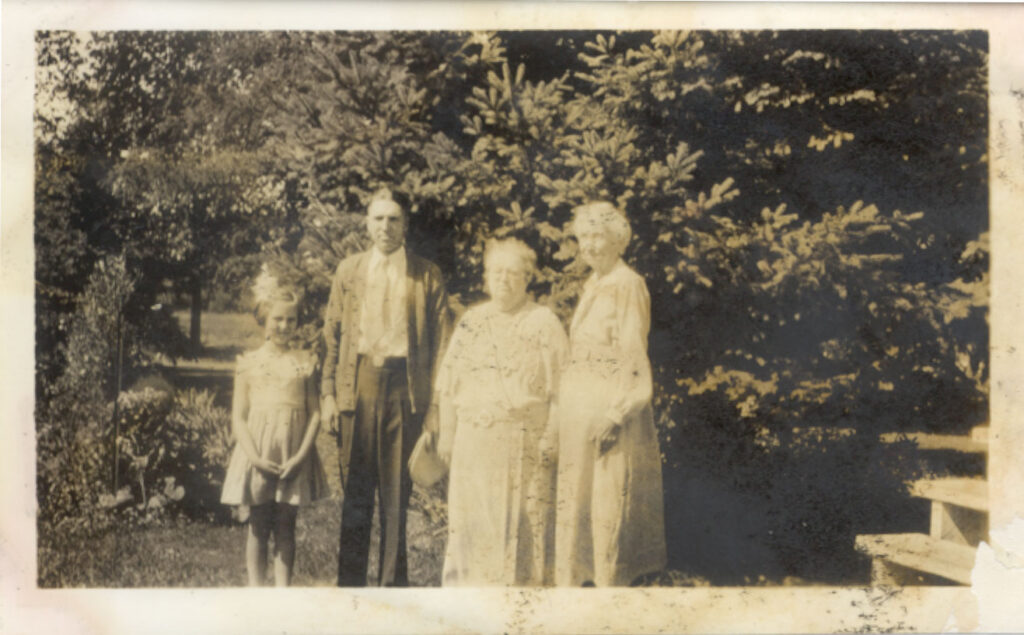
His funeral was held at his home on Tuesday, September 6th. He was buried in nearby Pine Grove Cemetery, and the “local mail carriers marched in uniform from the Cook residence to the cemetery.”10
Today is my dad’s birthday. He was born September 18, 1934, 14 days after the death of his grandfather, 90 years ago.

SOURCES:
- “One Man’s Job,” Lewis H. Cook, Wausau Daily Record-Herald, 16 Mar 1929, Saturday Evening, p. 6, col. 5; digital images, Newspapers.com (www.newspapers.com : accessed 2 May 2024). ↩︎
- ibid. ↩︎
- “Wausau Postoffice Completes a Most Outstanding Year,” Wausau Daily Record-Herald, 31 Dec 1929, Tuesday Evening, p. 6, col. 3; digital images, Newspapers.com (www.newspapers.com : accessed 2 May 2024). ↩︎
- “Contractors Asked To Enter Bids on Wausau Postoffice,” Wausau Daily Record-Herald, 16 Mar 1929, Sunday Evening, p. 1, col. 1; digital images, Newspapers.com (www.newspapers.com : accessed 5 May 2024). ↩︎
- “Parking Space,” Wausau Daily Record-Herald, 11 Jun 1934, Monday Evening, p. 2, col. 2; digital images, Newspapers.com (www.newspapers.com : accessed 27 Apr 2024). ↩︎
- “Veteran’s Caskets To Be Draped With Government Flags,” Wausau Daily Record-Herald, 16 Jul 1931, Thusday Evening, p. 1, col. 4; digital images, Newspapers.com (www.newspapers.com : accessed 30 Apr 2024). ↩︎
- “State Postmasters Arrive for Annual Convention in City,” Wausau Daily Record-Herald, 19 Jun 1934, Tuesday Evening, p. 1, col. 1; digital images, Newspapers.com (www.newspapers.com : accessed 27 Apr 2024). ↩︎
- ibid. ↩︎
- “State Postmasters Arrive for Annual Convention in City,” Tuesday Evening, p. 13, col. 3. ↩︎
- “Cook Funeral,” Obituary, Wausau Daily Record-Herald, 8 Sep 1934, Saturday, p. 2, col. 4. ↩︎
